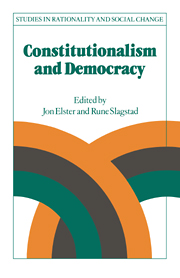Book contents
- Frontmatter
- Contents
- Notes on contributors
- Introduction
- 1 Gag rules or the politics of omission
- 3 Democracy as a contingent outcome of conflicts
- 3 Consequences of constitutional choice: reflections on Tocqueville
- 4 Liberal constitutionalism and its critics: Carl Schmitt and Max Weber
- 5 Democracy and the rule of law: some historical experiences of contradictions in the striving for good government
- 6 Neo-federalism?
- 7 Precommitment and the paradox of democracy
- 8 American constitutionalism and the paradox of private property
- 9 From liberal constitutionalism to corporate pluralism: the conflict over the enabling acts in Norway after the Second World War and the subsequent constitutional development
- 10 Arguments for constitutional choice: reflections on the transition to socialism
- 11 Constitutions and democracies: an epilogue
- Index
5 - Democracy and the rule of law: some historical experiences of contradictions in the striving for good government
Published online by Cambridge University Press: 05 June 2012
- Frontmatter
- Contents
- Notes on contributors
- Introduction
- 1 Gag rules or the politics of omission
- 3 Democracy as a contingent outcome of conflicts
- 3 Consequences of constitutional choice: reflections on Tocqueville
- 4 Liberal constitutionalism and its critics: Carl Schmitt and Max Weber
- 5 Democracy and the rule of law: some historical experiences of contradictions in the striving for good government
- 6 Neo-federalism?
- 7 Precommitment and the paradox of democracy
- 8 American constitutionalism and the paradox of private property
- 9 From liberal constitutionalism to corporate pluralism: the conflict over the enabling acts in Norway after the Second World War and the subsequent constitutional development
- 10 Arguments for constitutional choice: reflections on the transition to socialism
- 11 Constitutions and democracies: an epilogue
- Index
Summary
The rule of law and democracy correspond to the two different concepts of liberty, the negative, which makes liberty dependent on the curbing of authority, and the positive, which makes it dependent on the exercising of authority. These two concepts of liberty are, according to Isaiah Berlin, “two profoundly divergent and irreconcilable attitudes to the ends of life.” The claims of each of them have, however, “an equal right to be classed among the deepest interests of mankind” (1958, pp. 51–2). With regard to political order, Berlin seems to take the somewhat pessimistic view that a synthesis is impossible, that there ought to be some sort of compromise. This same view is taken by, for instance, Robert G. McCloskey when he writes about the “dualism of the American mind”: the propensity of the Americans “to divide their political hearts between the will of the people and the rule of law” (1960, p. 13). Is there really such a contradiction between democracy and the rule of law?
In the constitutionalist or rule of law tradition in the seventeenth and eighteenth century there was a marked tendency to see a contradiction. The opposites were despotism and rule of law and, as Kant for instance maintained, democracy was “im eigentlichen Verstande desr Worts notwendig ein Despotismus” (Kant 1976, p. 28). The authors in this tradition chose to favor rule of law so easily first, because when they talked about “democracy,” which they did not do very often, they meant a plebiscitarian democracy.
- Type
- Chapter
- Information
- Constitutionalism and Democracy , pp. 131 - 152Publisher: Cambridge University PressPrint publication year: 1988
- 8
- Cited by



